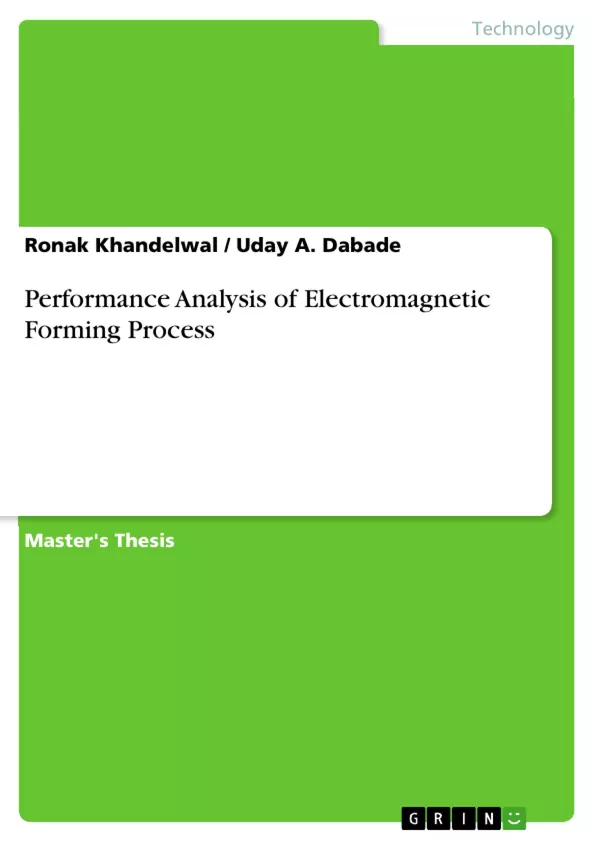Electromagnetic Forming Process (EMF) is advanced high velocity metal forming process which deals with the application of high energy magnetic surge for very short duration of time in order to attain desired deformation. In this work, simulation of EMF process for tube bulging is performed and experimental validation is carried out. For simulation, COMSOL Multiphysics software is used. Simulation is performed for two material, aluminium 6063-O and copper. The results of simulation are validated by experiments on aluminum tube.
Table of Contents
- Introduction
- Literature Review
- Modelling and Simulation
- Software Used for Simulation
- Coil
- Material Selection
- Process Parameters
- Response Variable
- Simulation of Experiments
- Experimental Work, Results and Analysis
- Machine Selection
- Experimental Results
- Analysis of Results
- Confirmatory Experiments
- Additional Experiments
- Conclusions
Objectives and Key Themes
This dissertation aims to perform a simulation of the Electromagnetic Forming (EMF) process for tube bulging and validate the simulation results experimentally. The study uses COMSOL Multiphysics software for simulation and the Taguchi Method for design of experiments. The focus is on analyzing the impact of key process parameters on the deformation of the workpiece.
- Simulation of the EMF process for tube bulging using COMSOL Multiphysics.
- Experimental validation of the simulation results.
- Analysis of the influence of process parameters (discharge energy, stand-off distance, workpiece thickness) on deformation.
- Application of the Taguchi Method for experimental design and ANOVA for results analysis.
- Determination of the most significant parameters affecting deformation in the EMF process.
Chapter Summaries
Introduction: This chapter introduces the Electromagnetic Forming (EMF) process, detailing its working principles, advantages (excellent surface finish, high repeatability, negligible springback, high flexibility), and disadvantages (use of conductive materials, safety concerns, low efficiency). It establishes the objectives of the research, which center on simulating and experimentally validating the EMF process for tube bulging, focusing on the impact of key process parameters. The methodology, involving COMSOL Multiphysics simulation and experimental work using the Taguchi method, is outlined.
Literature Review: This chapter provides a comprehensive review of existing literature on the EMF process. It delves into the physics governing the process, specifically the generation of electromagnetic (Lorentz) forces through the interaction of magnetic fields and conductive workpieces. This section likely examines prior research on simulation techniques, experimental methodologies, and the influence of various process parameters on the final outcome of EMF processes, providing a theoretical foundation for the current research.
Modelling and Simulation: This chapter details the simulation process using COMSOL Multiphysics software. It describes the design and fabrication of the solenoid copper coil, the selection of materials (aluminum 6063-0 and copper), and the definition of process parameters (discharge energy, stand-off distance, workpiece thickness). The chapter explains the selection of a response variable (deformation) and the methodology for simulating experiments using the defined parameters and levels. The simulation results, showing the effect of parameter variations on tube bulging, are presented and analyzed.
Experimental Work, Results and Analysis: This chapter presents the experimental setup, including machine selection and procedures. It reports the experimental results obtained for tube bulging under different combinations of process parameters. The data is analyzed using ANOVA (Analysis of Variance) to assess the statistical significance of each parameter's influence on deformation. AOM (Analysis of Means) plots generated using MINITAB 16 software visualize the effects of each parameter, helping to determine the optimal parameter combination for maximum deformation. Confirmatory and additional experiments are likely performed to validate the findings.
Keywords
Electromagnetic Forming (EMF), COMSOL Multiphysics, Taguchi Method, Lorentz Force, ANOVA, AOM plot, stand-off distance, springback, tube bulging, aluminum 6063-0, copper, discharge energy, workpiece thickness.
Frequently Asked Questions: Electromagnetic Forming (EMF) Process Simulation and Experimental Validation
What is the main objective of this dissertation?
The dissertation aims to simulate the Electromagnetic Forming (EMF) process for tube bulging using COMSOL Multiphysics and validate the simulation results experimentally. It focuses on analyzing how key process parameters impact workpiece deformation.
What software and methodology were used for the simulation?
COMSOL Multiphysics software was used for the simulation. The Taguchi Method was employed for the design of experiments.
What are the key process parameters investigated?
The key process parameters investigated include discharge energy, stand-off distance, and workpiece thickness.
What materials were used in the study?
Aluminum 6063-0 and copper were used as the workpiece and coil materials, respectively.
What is the response variable in this study?
The response variable is the deformation of the tube during the bulging process.
How were the experimental results analyzed?
The experimental results were analyzed using ANOVA (Analysis of Variance) and AOM (Analysis of Means) plots generated using MINITAB 16 software.
What are the advantages and disadvantages of the Electromagnetic Forming (EMF) process?
Advantages include excellent surface finish, high repeatability, negligible springback, and high flexibility. Disadvantages include the need for conductive materials, safety concerns, and low efficiency.
What are the key themes explored in this dissertation?
Key themes include the simulation of the EMF process, experimental validation of simulation results, analysis of parameter influence on deformation, application of the Taguchi method and ANOVA, and determination of the most significant parameters affecting deformation.
What are the chapter summaries?
The dissertation includes chapters on Introduction (introducing EMF and research objectives), Literature Review (reviewing existing EMF research), Modelling and Simulation (detailing the simulation process with COMSOL), Experimental Work, Results and Analysis (presenting experimental setup, results, and statistical analysis), and Conclusions.
What are the keywords associated with this research?
Keywords include Electromagnetic Forming (EMF), COMSOL Multiphysics, Taguchi Method, Lorentz Force, ANOVA, AOM plot, stand-off distance, springback, tube bulging, aluminum 6063-0, copper, discharge energy, and workpiece thickness.
- Quote paper
- Ronak Khandelwal (Author), Prof. Dr. Uday A. Dabade (Author), 2014, Performance Analysis of Electromagnetic Forming Process, Munich, GRIN Verlag, https://www.grin.com/document/305740



